I am trying to build a ML model. However I am having difficulties in understanding where to apply the encoding. Please see below the steps and functions to replicate the process I have been following.
First I split the dataset into train and test:
# Import the resampling package
from sklearn.naive_bayes import MultinomialNB
import string
from nltk.corpus import stopwords
import re
from sklearn.model_selection import train_test_split
from sklearn.feature_extraction.text import CountVectorizer
from nltk.tokenize import RegexpTokenizer
from sklearn.utils import resample
from sklearn.metrics import f1_score, precision_score, recall_score, accuracy_score
# Split into training and test sets
# Testing Count Vectorizer
X = df[['Text']]
y = df['Label']
X_train, X_test, y_train, y_test = train_test_split(X, y, test_size=0.2, random_state=40)
# Returning to one dataframe
training_set = pd.concat([X_train, y_train], axis=1)
Now I apply the (under) sampling:
# Separating classes
spam = training_set[training_set.Label == 1]
not_spam = training_set[training_set.Label == 0]
# Undersampling the majority
undersample = resample(not_spam,
replace=True,
n_samples=len(spam), #set the number of samples to equal the number of the minority class
random_state=40)
# Returning to new training set
undersample_train = pd.concat([spam, undersample])
And I apply the algorithm chosen:
full_result = pd.DataFrame(columns = ['Preprocessing', 'Model', 'Precision', 'Recall', 'F1-score', 'Accuracy'])
X, y = BOW(undersample_train)
full_result = full_result.append(training_naive(X_train, X_test, y_train, y_test, 'Count Vectorize'), ignore_index = True)
where BOW is defined as follows
def BOW(data):
df_temp = data.copy(deep = True)
df_temp = basic_preprocessing(df_temp)
count_vectorizer = CountVectorizer(analyzer=fun)
count_vectorizer.fit(df_temp['Text'])
list_corpus = df_temp["Text"].tolist()
list_labels = df_temp["Label"].tolist()
X = count_vectorizer.transform(list_corpus)
return X, list_labels
basic_preprocessing is defined as follows:
def basic_preprocessing(df):
df_temp = df.copy(deep = True)
df_temp = df_temp.rename(index = str, columns = {'Clean_Titles_2': 'Text'})
df_temp.loc[:, 'Text'] = [text_prepare(x) for x in df_temp['Text'].values]
#le = LabelEncoder()
#le.fit(df_temp['medical_specialty'])
#df_temp.loc[:, 'class_label'] = le.transform(df_temp['medical_specialty'])
tokenizer = RegexpTokenizer(r'\w+')
df_temp["Tokens"] = df_temp["Text"].apply(tokenizer.tokenize)
return df_temp
where text_prepare is:
def text_prepare(text):
REPLACE_BY_SPACE_RE = re.compile('[/(){}\[\]\|@,;]')
BAD_SYMBOLS_RE = re.compile('[^0-9a-z #+_]')
STOPWORDS = set(stopwords.words('english'))
text = text.lower()
text = REPLACE_BY_SPACE_RE.sub('', text) # replace REPLACE_BY_SPACE_RE symbols by space in text
text = BAD_SYMBOLS_RE.sub('', text) # delete symbols which are in BAD_SYMBOLS_RE from text
words = text.split()
i = 0
while i < len(words):
if words[i] in STOPWORDS:
words.pop(i)
else:
i += 1
text = ' '.join(map(str, words))# delete stopwords from text
return text
and
def training_naive(X_train_naive, X_test_naive, y_train_naive, y_test_naive, preproc):
clf = MultinomialNB() # Gaussian Naive Bayes
clf.fit(X_train_naive, y_train_naive)
res = pd.DataFrame(columns = ['Preprocessing', 'Model', 'Precision', 'Recall', 'F1-score', 'Accuracy'])
y_pred = clf.predict(X_test_naive)
f1 = f1_score(y_pred, y_test_naive, average = 'weighted')
pres = precision_score(y_pred, y_test_naive, average = 'weighted')
rec = recall_score(y_pred, y_test_naive, average = 'weighted')
acc = accuracy_score(y_pred, y_test_naive)
res = res.append({'Preprocessing': preproc, 'Model': 'Naive Bayes', 'Precision': pres,
'Recall': rec, 'F1-score': f1, 'Accuracy': acc}, ignore_index = True)
return res
As you can see the order is:
- define text_prepare for text cleaning;
- define basic_preprocessing;
- define BOW;
- split the dataset into train and test;
- apply the sampling;
- apply the algorithm.
What I am not understanding is how to encode text correctly in order to make the algorithm working fine. My dataset is called df and columns are:
Label Text Year
1 bla bla bla 2000
0 add some words 2012
1 this is just an example 1998
0 unfortunately the code does not work 2018
0 where should I apply the encoding? 2000
0 What am I missing here? 2005
The order when I apply BOW is wrong as I get this error: ValueError: could not convert string to float: 'Expect a good results if ... '
I followed the steps (and code= from this link: kaggle.com/ruzarx/oversampling-smote-and-adasyn . However, the part of sampling is wrong as it should be done only to the train, so after the split. The principle should be: (1) split training/test; (2) apply resampling on the training set, so that the model is trained with balanced data; (3) apply model to test set and evaluate on it.
I will be happy to provide further information, data and/or code, but I think I have provided all the most relevant steps.
Thanks a lot.
